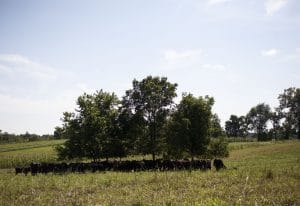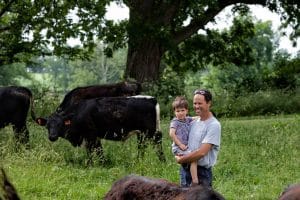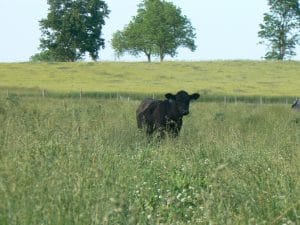Growing produce is mostly what we do and what you see at the farmers markets, but it is important to address the idea that cattle are an integral part of Elmwood Stock Farm, too. They not only convert solar energy into wholesome meat, they are also a valuable tool in our vegetable-production toolbox. From nutrient cycling to weed eaters, the farm-improvement services they perform keep us from having to do them.

The momma cows grew up here, so our cattle know every nook and cranny of the farm, probably better than we do. And there is no better place than the Central Bluegrass region to raise them. The soils of the Inner Bluegrass have a balance of nutrients particularly beneficial to livestock that consume the forages grown on them, which is why the horse industry developed in this region.
The hilly lands on the farm are maintained as permanent pasture, never to see a plow, because the erosion potential is too high. This wisdom has been handed down for generations, meaning some fields look just as they did decades ago. Other fields may have been natural grasslands, meaning the roaming herds of buffalo grazed here millennia ago, as they were never forested. There is a large portion of Elmwood Stock Farm in pasture, and we are glad to have it.
To our farm-tour guests, these seem like idle grassy areas. These fields are far from idle, though. The roots of the plants that grow there year-round hold the soil firmly in place. These plants also convert solar energy into complex carbohydrates, proteins, vitamins and minerals though the photosynthesis process, which is exactly what bovines thrive on.
But cattle do not just bite off whatever they find in a field. They selectively pick and choose which plants, or even parts of plants, they will pack into their stomachs to ruminate. Depending on how mature the plants are, which is a function of how long it has been since they were last grazed or mowed, the cattle will nip off the tops of each plant where the leaves are young and tender. Other times, they will nose through the weeds to locate the more desirable species, like the clovers, and bite off the whole plant. It’s interesting to watch as they take dozens of bites without ever lifting their heads, somehow working the feed up the esophagus before it moves into the second of their four stomachs.
Since none of us like, nor would do well eating, fescue or clover, I’m really glad that cattle do. The cattle do a marvelous job of stripping weed seeds from the tops of plants as the seeds ripen, too. They have been seen eating thistle flowers when the flowers are just turning purple. We used to worry when they ate plants considered to be poisonous, but it must be their inherent way of warding off parasites or sourcing micronutrients. In this way, they are converting the energy the plants captured from the sun and producing high-quality beef for us to consume, all while the plants are holding and building soil.
 Our forefathers went into the cattle business, and the animals in the herd we have today are the offspring of those that came before them. For decades, the best young females have been kept back as replacement heifers based on their conformation, disposition, and a whole host of intangibles, such as how their momma, grandmomma and daddy performed: good mothering, good milker, strong bone structure and the ability to perform well in a grass-based system, to name a few.
Our forefathers went into the cattle business, and the animals in the herd we have today are the offspring of those that came before them. For decades, the best young females have been kept back as replacement heifers based on their conformation, disposition, and a whole host of intangibles, such as how their momma, grandmomma and daddy performed: good mothering, good milker, strong bone structure and the ability to perform well in a grass-based system, to name a few.
Much is known about each individual cow; many stories can be told. They all have numbers, have their place in the pecking order, have unique quirks, yet collectively, they are managed as a herd. In the early days, Elmwood Stock Farm built a reputation for selling quality bulls to nearby farms as herd sires, which we still do. Since the bull represents 50 percent of the genetics of a commercial cowherd, we are proud to have had a positive impact on other farms around Kentucky and beyond.
These are beasts—some well over a thousand pounds—that eat a lot. We have evolved in our thinking on how best to feed them. First, they are divided into groups based on their stage of life, which translates into their required plane of nutrition and annual reproductive cycles. Second, we move each group from pasture to pasture as they graze down the forage available to them.
Nursing and pregnant mothers get moved to fresh grass every few days. We do this with temporary electric fence systems that are a quick and easy way to divide up a field. The decision on where the fence goes is dependent on how big the paddock needs to be for two to three days of grazing, which is dependent on how tall, thick and lush the grass is. When the calves are weaned at 7 or 8 months, they go off as a group of their own and are given their own rotation of fresh forage every few days. As the weanlings mature, we often have several groups based on size and forage availability. The mature bulls hang out in lush, expansive bull lots, impatiently waiting the next breeding season.
There is a shared understanding within the herds as to how this rotation thing works. The cows are keenly aware when the field they are in is eaten down or picked over. When they hear the Kubota coming, even before they can see it, they begin moving toward the place they think access to their next paddock will be gained. We generally have the next couple of paddocks laid out ahead of time, so when it is time to move, it is as simple as rolling up the wire on a spool, allowing the group to flow into the fresh field, and then closing it back behind them. We gauge how aggressively they begin eating to see if we made them wait too long or, if they’re not hungry, not long enough. This is a balancing act, as we want them to stay long enough to uniformly capture all the forage, but we do not want to compromise their nutrient intake. Either way, there is no need to herd the herd; they freely move on their own.
Their behavior tells us a lot about how they are performing. They instinctively prefer to stay in a herd, or closely bunched up, as a protection mechanism, even though we have no lions, or tigers, or cheetahs in Kentucky. This behavior is, in part, due to how they eat. The herd will leave the security of the trees, to fill their largest of four stomachs, the rumen, as quickly as they can, only to retreat to the higher ground and/or shade trees to chew their cud and rest. The word ruminate comes from them coughing up a small portion of the minimally processed grass in order to further masticate the feed and extract all the nutrients. Watching them chew their cud, they look very peaceful, almost as if they are half asleep, which gets back to the security of a herd. A herd of tens of thousands of pounds of bovine is a force to reckon with, which is why we make sure they always have feed and water and shade available at all times.
The mothers are very protective of their calves, which makes catching the 1- or 2-day-old calves and holding them to give them ear tags with numbers on them an exciting time. It is also one of the few times we ever lay hands on them. It is fascinating how 50 black calves know which of the 50 black momma cows is theirs, even in the dark. We take all this into consideration as we determine where the gates will be, how they access water, how much shade they need and other forms of animal husbandry.
 So, how does all this impact the produce we grow? Winter hay feeding is done on next year’s vegetable fields, which moves the nutrients to where they are most beneficial. In the fall, the herd moves through the expired produce crop fields and tramples any weeds that they do not eat.
So, how does all this impact the produce we grow? Winter hay feeding is done on next year’s vegetable fields, which moves the nutrients to where they are most beneficial. In the fall, the herd moves through the expired produce crop fields and tramples any weeds that they do not eat.
We consider ourselves grass farmers. Our daily livestock-feeding decisions are all about how much grass there is in a particular field, how much grass should be grazed and how much cut for hay, how mature are the plants, how much rain are we getting to predict regrowth after grazing. By simply moving the cattle, we allow them to do most of the work. The other beauty of all this moving cattle around? It eliminates the need for synthetic chemical parasiticides, because they don’t have internal parasites to deal with.
If you get a bunch of cattle farmers together, the phrase “workin’ cattle” means herding them into a corral to give them shots and stuff. At Elmwood Stock Farm, it means they are the ones doing work to help us grow vegetables and convert forage into food. The next time you enjoy some of our grass-fed, certified-organic, USDA Choice, dry-aged Angus beef, just remember how integral it is to our whole farm-management system. —Mac Stone


Made with 
